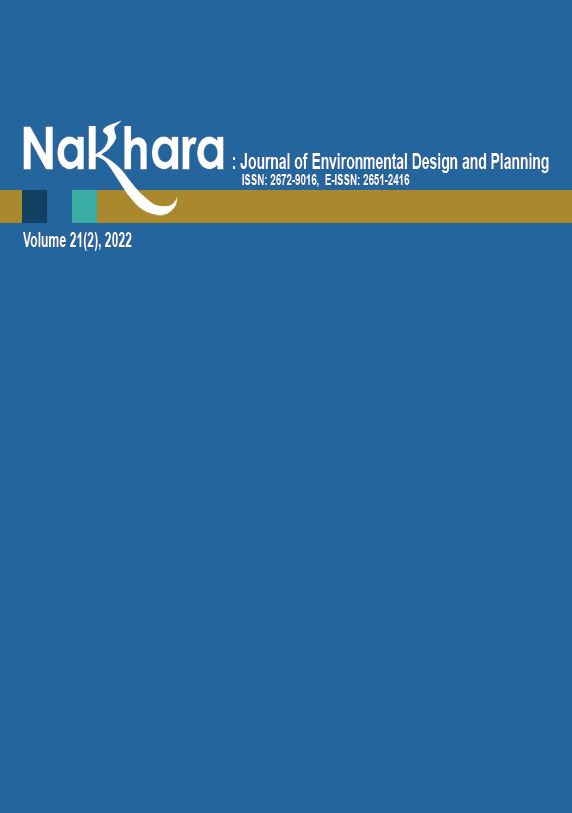3D Data Visualization and Analysis Tools for AI Ready City: Space Syntax and Social Media Data
Main Article Content
Abstract
Space syntax is now widely accepted as a set of techniques that can be used to efficiently analyze spatial morphological structure at the city or community level. Segment analysis, a type of space syntax that is typically rendered through two-dimensional vector lines, can show the effectiveness of pedestrian and vehicular accesses to parts of a city. However, analysis of a city’s condition is far too diverse and complex for the use of space syntax alone. Other types of information, such as data from social media, can be integrated to determine and locate problems in the city, or to search for areas with potential for development. These types of data help in analyzing the quality of experience for those using the urban spaces, and they can be obtained by compiling the judgements of actual city dwellers, or by using advanced technologies to create a more realistic virtual reality and letting system users be the judges. The purpose of this research is to develop a 3D model and a virtual reality system capable of displaying the results of 3D urban morphological analysis, using space syntax segment analysis and social media data from urban space users to support the collaboration and communication among architects, designers, urban planners, city policy makers, or other city stakeholders. The virtual 3D model was created by using photogrammetry from aerial photographs, as well as a low polygon model built with referenced data from the photogrammetry model for faster rendering. The area of Thammasat University, Rangsit Center, was used as the prototype area for the AI Ready City.
Article Details

This work is licensed under a Creative Commons Attribution-NonCommercial-NoDerivatives 4.0 International License.
References
Andrade, R., & Schieck, F.G. A. (2014). Wayfinding to support urban exploration: Combining space syntax analysis with social media data for navigation system design. Proceedings of the 10th International Space Syntax Symposium, 1751–1769.
Bafna, S. (2003). Space Syntax: A brief introduction to its logic and analytical techniques. Environment and Behavior, 35(1), 17–29. https://doi.org/10.1177/0013916502238863
Barber, D., Mills, J., & Bryan, P. (2001, September 18-21). Laser scanning and photogrammetry: 21st century metrology [Paper presentation]. CIPA Symposium, Potsdam, Germany.
Bilke, L., Fischer, T., Helbig, C., Krawczyk, C., Nag, T., Naumov, D., & Pualick, S. (2014). TESSIN VISLab - laboratory for scientific visualization. Environmental Earth Sciences, 72, 3881–3899. http://doi:10.1007/s12665-014-3785-5
Campbell, A, D., & Wells, M. (1994). A critique of virtual reality in the architectural design process (R-94-3). Human Interface Technology Laboratory, University of Washington. http://papers.cumincad.org/data/works/att/0e58.content.pdf
Cerfontaine, P., Mreyen, A. S., & Havenith, B. H. (2016). Immersive visualization of geophysical data. In 2016 International Conference on 3D Imaging (IC3D), 1–6. https://doi.org/10.1109/IC3D.2016.7823445
Debevec, E. P., Taylor, J. C., & Malik, J. (1996). Modeling and rendering architecture from photographs: A hybrid geometry and imagebased approach. SIGGRAPH96: 23rd International Conference on Computer Graphics and Interactive Techniques, (pp. 11–20). https://doi.org/10.1145/237170.237191
Edelsbrunner, H. (2001). Geometry and topology for mesh generation. Cambridge University Press.
Fitzner, B. & Heinrichs, K. (2002). Damage diagnosis on stone monuments— weathering forms, damage categories and damage indices. In R. Prikryl & H.A. Viles (Eds.), Understanding and Managing Stone Decay, Proceeding of the International Conference “Stone Weathering and Atmospheric Pollution Network (SWAPNET 2001)”, Prachov Rocks, (pp. 11–56).
Frey P., Sarter B., & Gautherie M. (1994). Fully automatic mesh generation for 3-D domains based upon voxel sets. International Journal of Methods in Engineering, 2735–2753.
García-Cortés, S., Galán, C. O., Argüelles-Fraga, R. and Díaz, A. M. (2012). Automatic detection of discontinuities from 3D point clouds for the stability analysis of jointed rock masses. 18th International Conference on Virtual Systems and Multimedia, (pp. 595–598). https://doi.org/10.1109/VSMM.2012.6365985
Hartley. R.I., & Zisserman, A. (2004). Multiple view geometry. Cambridge University Press.
Hillier, B., & Hanson, J. (1984). The social logic of space. Cambridge University Press.
Jiangfan, F. (2013). Virtual reality: An efficient way in GIS classroom teaching. IJCSI International Journal of Computer Science, 3, 363–367.
Kádár, B., & Gede, M. (2013). Where do tourists Go? Visualizing and analysing the spatial distribution of geotagged photography. Cartographica: The International Journal for Geographic Information and Geovisualization, 48(2), 78–88.
Lv, Z., Yin, T., Zhang, X., Song, H., & Chen, G. (2016). Virtual reality smart city based on webVRGIS. IEEE Internet of Things Journal, 3(6), 15–24. https://doi.org/10.1109/JIOT.2016.2546307
Mao, T. (2015). Mining one hundred million creativecommons Flickr images dataset to Flickr tourist index. International Journal of Future Computer and Communication, 4(2), 104–107.
Smith, P., & Sritharan, S. S. (1988). Theory of harmonic grid generation. Complex Variables,10, 359–369.

